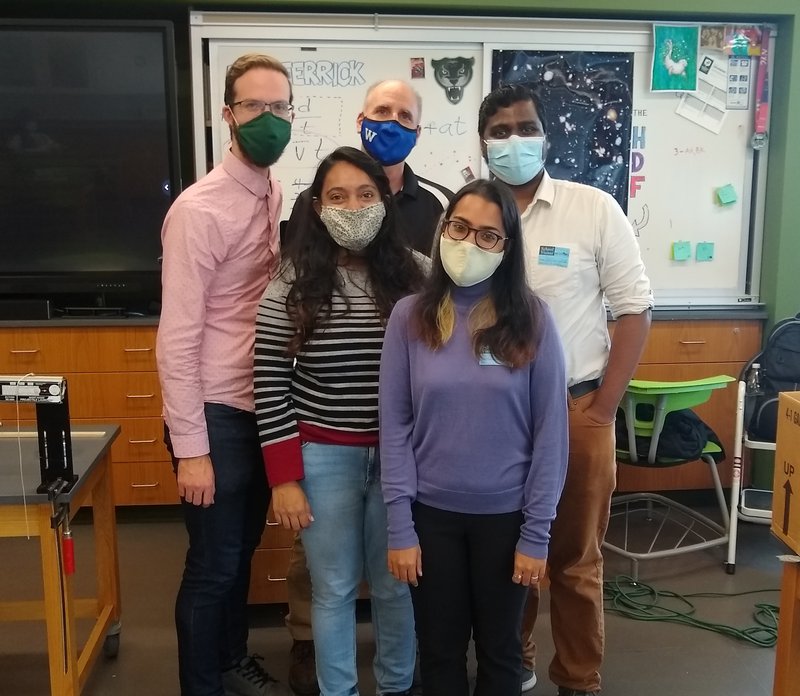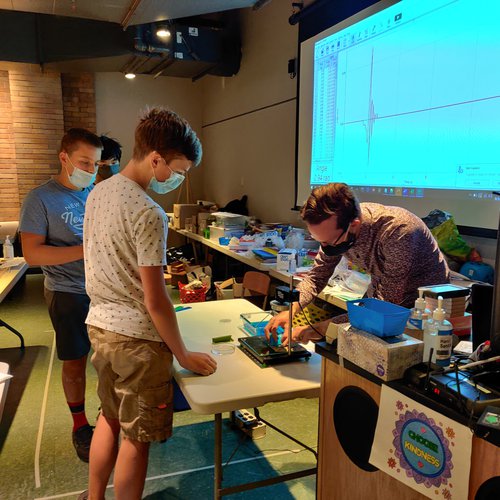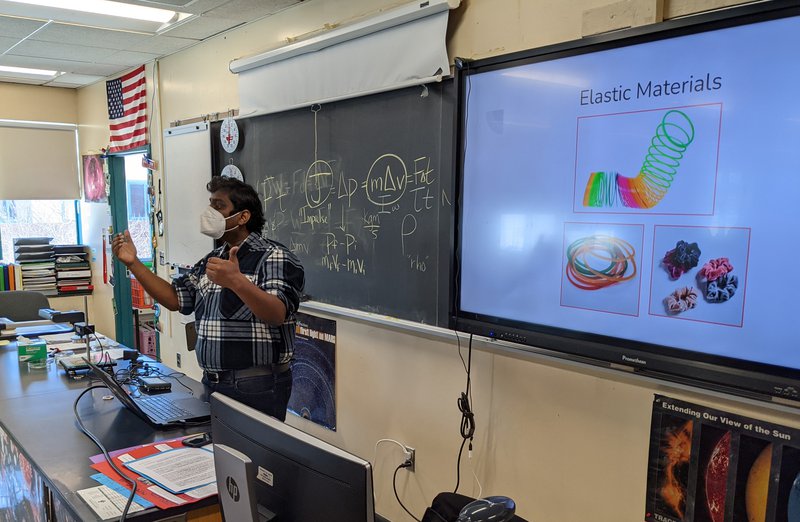by Laura Wallis
“When am I ever going to use this in real life?” That is the oft-heard refrain from middle- and high-school science students, struggling through labs and formulas that feel as far removed from their day-to-day as, well, space travel. Sarthak Gupta and Merrill Asp, graduate students in the physics department of the College of Arts and Sciences, are working to answer that question one student at a time, through hands-on experiments and demonstrations in local classrooms, thanks to an outreach program funded by a 2021-22 grant from the New York State section of the American Physical Society (APS).

Physics graduate students Merrill Asp (left) and Sarthak Gupta (right) at an outreach event at Westhill High School in Syracuse.
Recently, we spoke to them about the beginnings of the program, how their work with students has taken shape so far, and what they’ve got planned next.
Q: How did the physics outreach program come about?
Merrill Asp: We saw the funding opportunity from APS, and thought, ‘what can we contribute to outreach?’.
Sarthak Gupta: The idea we had was to take research from universities to schools, so students could see how what they’re learning now will be used in the future.
MA: In science education, it can feel like these subjects are a closed book, like everything is already figured out. But people like us are pursuing research questions all the time, and the larger academic world is always looking at unanswered questions.
Q: How far has the outreach gone?
MA: Our grant was for middle and high schools. We have visited eight classrooms in three Central New York-area high schools so far. We also visited the Museum of Science and Technology (MoST), which runs a summer camp for middle-school aged kids. The museum graciously allowed us a chunk of time to try out our lessons. We’ve reached out to hundreds of students already.
Q: Have there been challenges in connecting with schools and reaching the populations you particularly are hoping to reach?
SG: We’ve learned it [this outreach] has to be a longer-term process, getting hold of teachers, scheduling visits—to foster these relationships and then sustain them over time.
Q: Aside from scheduling, resources can be an obstacle in planning outreach visits. What are you doing to counter that?
SG: We realized that not all schools have equipment, so we bought what we needed to be self-sufficient. We don’t require anything from the schools except the space and time.
Q: What kinds of experiments have you been doing with the classes, and why did you choose them?
MA: For both of us, our background is in soft-matter physics. Which overlaps with bio-physics—the physics of living systems. It’s not what people tend to think about when they think physics. But that’s where a lot of the exciting open questions are.
Each of our demos introduces a single concept—one is diffusion, another is viscoelasticity. First with definitions, then showing how they work.
Q: Let’s start with the diffusion lesson. How does it work?
MA: We bring a fairly powerful microscope. The sample is just a well of water, but in it are tiny microscopic Styrofoam spheres. In the microscope, you can see those spheres being knocked into and jostled around by all these water molecules. We’re looking at something on a small enough scale that you can actually see diffusion—something moving from a higher concentration to a lower one—happen in real time.
After the demo we do a group activity, using a model called the random walk. We give all the students some graph paper and eight-sided dice, and they roll the dice and simulate on their graph paper a random moving path. At the end, we can put all these simulations together, and show how these random paths put together will simulate something spreading out. That’s diffusion.

Q: And viscoelasticity?
SG: The idea is that there are materials that are elastic [or solid-like]—like a rubber band that can be stretched and will return to shape—and some that are viscous, and will flow, like honey. But there are also materials that are in between, with properties of both.
We give a demo with a tabletop rheometer [an accessible and portable version of a lab tool that measures viscoelastic properties, developed a couple of summers ago in the lab of Professor Alison Patteson with local high school physics teacher Elise Jutzeler]. It’s basically a plate that comes down and rotates. The material [it’s measuring] will move, then it will go back. How much it goes back will depend on how elastic it is.
Then we do a fun activity. We have the students make a slime with borax, glue, water, and food color. The more borax you have in the solution, the more elastic the slime will be. To understand viscosity, you just pinch the slime: If it’s viscous, it will flow down slowly. But if it’s not, it will stay where it is. For the elastic property, you just make a ball and drop it on the table: If it’s elastic, it will bounce; if it isn’t, it will basically…splat.

A student stretching out slime that was created by mixing borax, glue, water and food coloring.
Q: So how to do these lessons translate to real-world applications?
MA: Diffusion is an important process for how cells take in food, how they excrete waste, how oxygen is transported in the blood—all driven by diffusion.
SG: Tissues in our bodies are viscoelastic materials. When cells move from one place to another, they go through tissue.
MA: There’s been a lot of research around how cancer cells or tumor cells are able to migrate to different parts of the body—and what allows them to is very much tied to how much the tissue and cells are solid-like versus fluid-like. We need to understand how those changes happen to understand cancer metastasis.
Q: How have the students received the lessons?
MA: In all the classes, the students have been very engaged and expressed interest, but at the end of most lessons, there are one or two kids who have lots and lots of extra questions. We’ll spend time at the end talking to them about our research.
SG: We’ve also gotten appreciation from teachers, for connecting those dots between what they’re teaching and the real-world meaning of them. They’ve told us the kids are waiting for us to come back again!
Q: And do you have any plans for how to keep that enthusiasm going?
SG: The research tells us that visiting a high school classroom once is not enough for the students to retain what they’ve learned. So part of the plan from the beginning was to do multiple visits to each classroom. To see how their levels of engagement and understanding were changing over the weeks. We hope to be able to do that.

Sarthak Gupta presenting to a class about elastic materials.
MA: And in the future, instead of taking our stuff to classrooms, we’d like to organize something to bring students to a new space, like to campus, where we could do new kinds of real-world demos in a hands-on fashion. The unique memory of that could have a significant impact for the students.
SG: [Another possibility is] connecting the labs we have here to local schools through research internships. So high schoolers can see the fun and the daily grind of a researcher.
SG: But [for now] we also encourage the students to learn more on their own. Physics is a collaborative subject, so after each demo we give them a worksheet and encourage them to talk in groups. We also give a handout with resources and more information about the lesson. On the back, we have a biography of a physicist from an underrepresented minority group with links to learn more. To show them you don’t have to be a certain kind of person to do physics. We want to inspire them.
We tell them, what you’re learning now, we do this on a daily basis in our research. There are the problems that are not solved yet—no one knows the answer. But you can do it.
About the Outreach Program:
Funding: a grant from the New York State section of the American Physical Society
Timeline: Application granted in spring 2021; program developed over the summer and outreach began in local schools in the fall
Participating schools (so far): Westhill High School, Jamesville-Dewitt High School in Syracuse, and with TST P-TECH Academy at Dryden, New York. And the summer camp program at the
Milton J. Rubenstein Museum of Science & Technology (MoST)
Team: Sarthak Gupta and Merrill Asp, as well as six other graduate and undergraduate students: Renita Saldanha, Prashali Chauhan, Nimisha Krishnan, Matt Cufari, Daniel Paradiso and Shabeeb Ameen.
Support provided by Professors Alison Patteson and Jen Schwarz, as well as department chair Professor Jennifer Ross and instructional lab manager Sam Sampere.
Assessment support provided by the Shaw Center.
